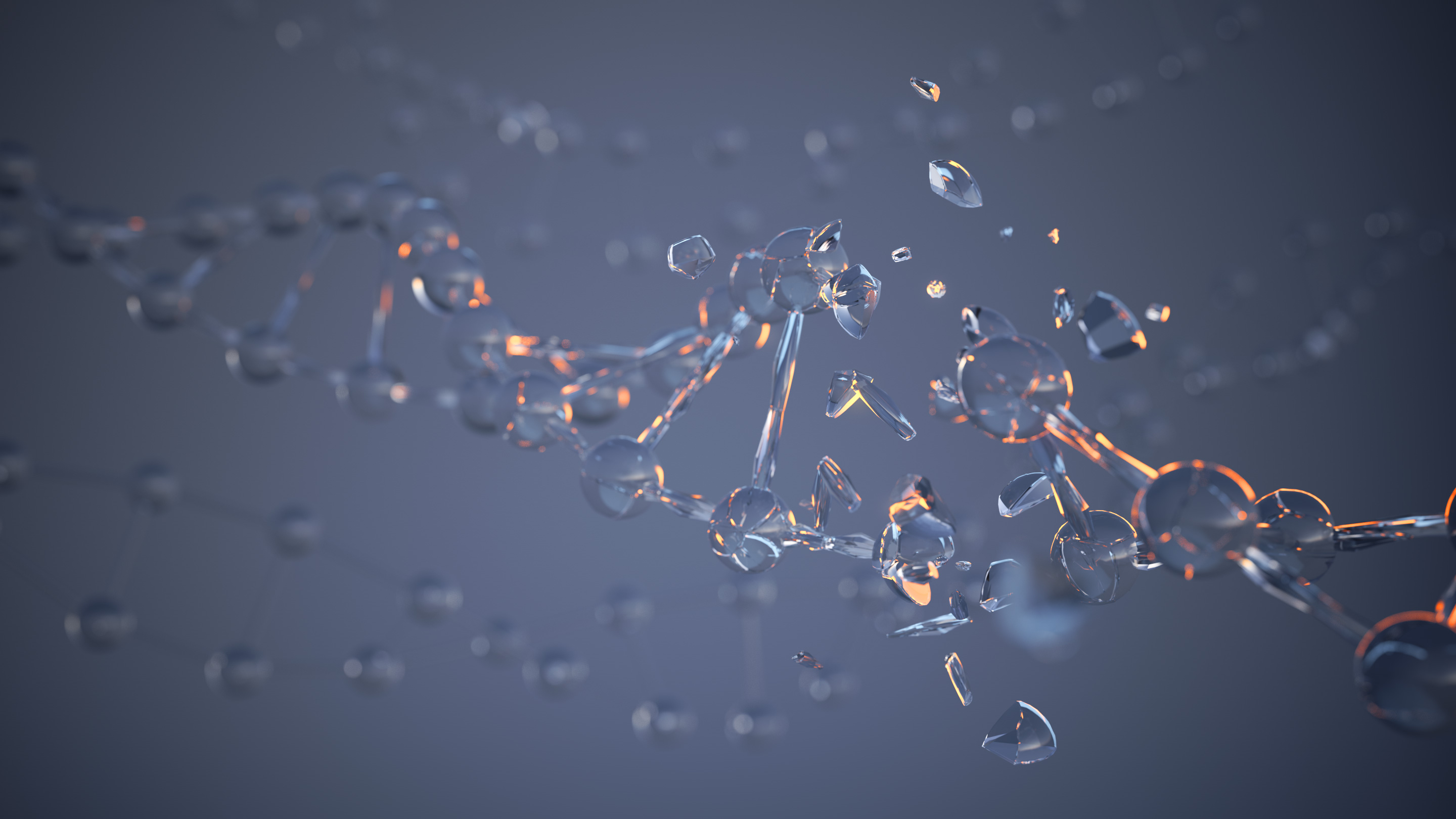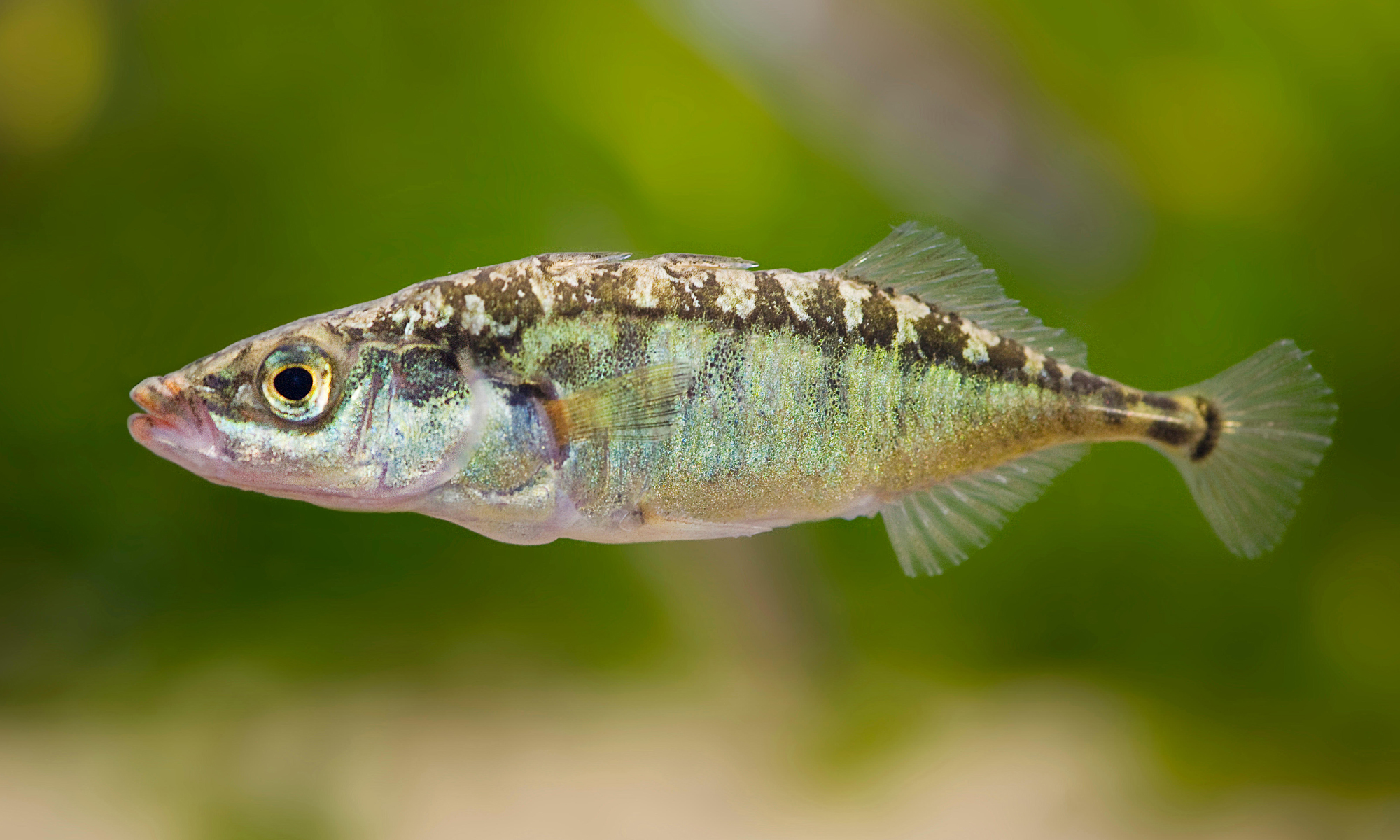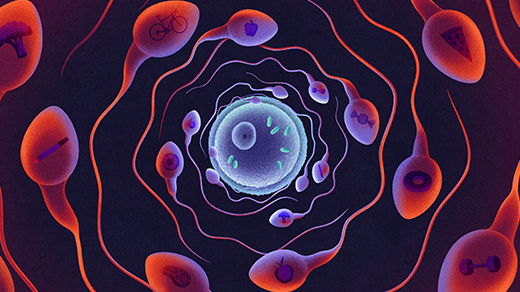Fragile DNA Enables New Adaptations to Evolve Quickly

Stretches of DNA that are rich in certain repeated sequences are “fragile” and can be lost easily, introducing mutations. They can be harmful, but they might also be the key to why some adaptations evolve over and over again.
Olena Shmahalo/Quanta Magazine
Introduction
Evolutionary biologists have puzzled over why nature, with vast genetic resources at its disposal, sometimes seems stuck in a rut. Against the odds, separate species and populations independently evolve the same solutions to life’s challenges, and the same genes are recruited to mutate and enable certain adaptations again and again. Now researchers at Stanford University think they have found part of the answer, at least for the fish called three-spine sticklebacks (Gasterosteus aculeatus).
According to a recent study described in Science, the stickleback’s DNA has fragile “hot spots” that are predisposed to break and mutate more often, with an accompanying loss of traits. The result is that these fish rapidly evolve the same adaptation — the loss of a pair of fins on their pelvis — repeatedly.
The discovery serves as a reminder that when looking at how mutations help with “survival of the fittest,” it’s also important to consider why those mutations occurred — “arrival of the fittest,” according to David Kingsley, the evolutionary geneticist whose lab conducted the study.
This work is “raising the specter that not all sites in the genome are equal. Some places are going to be more prone to mutation, and those may be meaningful for the repeated adaptation of populations,” said Sean B. Carroll, professor of biology at the University of Maryland and the director of science education at the Howard Hughes Medical Institute, who was not involved in the study. “I think that’s fascinating.”
Repetitive Mutations
About 10,000 years ago, the end of the last ice age created many new freshwater lakes and streams, as retreating glaciers filled depressions in the land with meltwater and some shifting waterways lost what had been their direct connections to the ocean. For some marine three-spine sticklebacks that lived off the coast but migrated inland to breed, this change in the landscape had huge consequences because they became trapped in the new lakes.
As these freshwater populations evolved in their new habitats, they frequently developed the same adaptations in parallel, one of which was the loss of their pelvic fin. No one is certain why evolution repeatedly favored that change, but it’s possible that the loss of the pelvic fins reduced the burden of building bone in freshwater environments where calcium and phosphate are limited. It may also have made it easier for the freshwater sticklebacks to evade some local predators.

In marine populations, the three-spine stickleback (Gasterosteus aculeatus) has a pair of pelvic fins on its underside. Evolution has repeatedly favored the loss of those fins in sticklebacks that adapted to life in freshwater lakes and streams.
For evolutionary geneticists who study the fish, like those in Kingsley’s laboratory, an obvious question was whether the parallel losses of the pelvic fin resulted from the same genetic changes or from different ones. There are many ways to “break” the development of a trait, just as there are many ways to break a complex piece of machinery, so there’s no a priori reason to think that the mutations would always occur in the same part of the genome.
But work in the Kingsley laboratory from 2010 and 2012 showed that the same genetic mechanisms were involved over and over again. The fish always seemed to lose a specific DNA regulatory region called the Pel enhancer, which drives the expression of a protein involved in pelvic fin development.
“So there was a surprising predictability to the genetic pathways that the fish were using as they adapted to a given set of environmental conditions,” Kingsley said. Kathleen Xie, who is now a research fellow at the Dana-Farber Cancer Institute in Boston, became curious about what molecular mechanism was making that evolutionary change so reproducible, and she made that question the focus of her doctoral thesis work in Kingsley’s laboratory.
One possible explanation was that the marine sticklebacks had already carried a rare mutation for the loss of the pelvic fin, one that arose in their ancestors. Once in fresh water, the stickleback populations could “reach into a bag of previously invented tricks,” Kingsley said, and put that existing mutation to a new use.
But that’s not what was happening: In each population, brand-new mutations were occurring in the Pel enhancer, Kingsley said. And in every case, the mutation involved the loss of hundreds to thousands of DNA base pairs.
When Xie, Kingsley and their lab colleagues looked more closely at the original marine form of the sticklebacks’ Pel enhancer, they found that it was unusually fragile: It broke 25 to 50 times more frequently than DNA sequences typically do. It also contained exceptionally long strings of alternating guanine and thymine DNA bases (GT repeats). The classic DNA structure is a right-handed double helix called B-DNA, but DNA can assume other structures, too. A string of GT repeats, however, can locally alter the structure to something more unusual, such as left-handed (or Z) DNA, which is prone to errors and breakage because cells have difficulty replicating it accurately. The fragility of the Pel sequence depends on the length of its string of GT repeats as well as the position of those repeats relative to where on the DNA the replication process begins.
“This is very interesting because any of those properties would be easy to change over the course of evolution,” Kingsley noted. If you altered the length of the GTs, changed the orientation of the GTs, or changed whether they’re replicated on the upper or the lower strand of DNA, all of those features can alter the fragility of the sequence and therefore the rate of mutation, he explained. Fragile DNA is normally bad for cells because it is associated with cancer and gene disruption. But in this case, for the fragility of the Pel enhancer to have survived, the strange sequences might also have provided some advantages.
Fragile DNA and Gene Expression
It’s easy to fall into the mistake of thinking that the main advantage was that fragility made the Pel gene highly evolvable so that it could enable an important adaptation if needed. But natural selection doesn’t place bets on traits that might be adaptive someday. Instead, Xie and Kingsley’s preferred hypothesis is that gene expression, not mutability, was the key: If the GT repeats stimulate gene expression in marine sticklebacks, then evolution may have originally favored them for helping those fish produce long, robust pelvic fins.
Adding and subtracting repeats would then have been an easy way to fine-tune the expression of the genes involved in pelvic fin development. Once the same letters are repeated by chance a few times, Kingsley explained, “the local repeat has a natural tendency to grow and shrink because of alignment errors that can occur between DNA strands during recombination or DNA replication.”
The fortuitous side effect was that the long sequence of GT repeats was also fragile and mutable. “The very tunability of the expression also makes them prone to ‘snapping the knob off’ the control panel completely,” Kingsley said, which could lead to a major change in body structure when the fishes’ environment changed drastically.
A mutation from the breakage of fragile DNA is different from the mutations caused by randomly arising single-nucleotide changes. When a fragile region breaks, it changes hundreds or thousands of base pairs – eliminating substantial chunks of regulatory sequences in one fell swoop. That allows for the rapid evolution of big, novel traits, not just the fine-tuning of existing features in the organism’s phenotype, or physical characteristics. “So I think they have a higher phenotypic effect than simply making a single base pair change,” Kingsley said. In this way, a bigger DNA lesion may produce a bigger change in the phenotype, which is then subject to stronger positive or negative selection, he added.
According to population genetics, a large mutation with a strong phenotypic effect has a higher chance of becoming fixed in a population, Kingsley said. In contrast, single base-pair mutations would be more likely to be lost randomly through a process of genetic drift.
“You have to think about both the ‘arrival of the fittest’ and ‘the survival of the fittest,’” Kingsley said. “Nonrandom biochemical properties are influencing the spectrum of mutations offered up to evolution,” and that can lead to the reuse of the same genetic mechanisms when an environment selects for a particular trait.
Losing DNA to Gain Traits?
Kingsley’s team has found at least 100 other locations in the marine sticklebacks’ genome that have abundant GT repeats, and they suspect those regions have similar fragility because they are often absent from the fishes’ freshwater descendants. The researchers are now investigating which traits are linked to those sequences. When the marine fish were adapting to fresh water, the loss of fragile DNA regions might have made traits other than the pelvic fin disappear — but Kingsley thinks it’s at least plausible that some of those DNA losses also triggered the emergence of entirely novel features in the freshwater species.
Michi Tobler, an evolutionary biologist at Kansas State University who studies parallel adaptations among fishes that live in highly toxic hydrogen sulfide springs in Mexico, is more skeptical of that possibility. If an organism needs a new trait to adapt to a novel environment, he said, “I’m not sure how that would happen through this increased likelihood of deletions in the genome that they’re documenting.”
But he agreed that the model Xie and Kingsley have suggested could be fruitful. “What the study has given us is a really new and exciting avenue to look at this problem of mutational input and how it shapes evolution,” he said. “We have something to look for now.”
Carroll made a similar point: “The interesting thing here is that if this mechanism operates at other loci [positions in the genome], we’re really going to want to understand the origins of these sequences and the forces that influence their gain, loss and retention in populations,” he said. “I think people are going to pay attention because they’ll look around and say, ‘Hey, is anything like this going on in something I’m studying?’”
It’s currently unclear how much evolution and adaptation are affected by mutation mechanisms like DNA fragility that produce unusual structural changes in the genome. Researchers have had a tendency to focus on single nucleotide changes, Kingsley said, because simple nucleotide changes are easy to score in genome analyses. Mechanisms that generate large mutations at elevated rates may be understudied.
But these large-effect mutations may play a more important role than has generally been acknowledged, Kingsley argues, especially in species with relatively small populations and long generation times, like humans. In a 2011 study, he and his colleagues found more than 500 loci where humans had completely deleted highly conserved, noncoding sequences since our ancestors split from those of chimpanzees more than 5 million years ago. More recently, as Xie and Kingsley noted in their stickleback paper, about half of the currently catalogued molecular changes that natural selection favored during human migrations around the world in the past 60,000 years were the result of mechanisms that produced frequent mutations. “And that’s just the cases we already know about,” he wrote in an email.
The new findings have sensitized Kingsley and his colleagues to the fact that, as in these fish, the genetic changes driving a species’ rapid evolution may not spread throughout a population purely because of their beneficial effects; they may also have special properties that make them occur more frequently. “That lesson,” he wrote, “can only help in the search for the causal basis of other interesting traits, whether in sticklebacks, or humans or other species.”
Correction added on Feb. 5, 2019: The description of the work on human genomes in the Kingsley lab was revised to clarify the nature and timing of the observed mutations and deletions.
Correction added on Feb. 6, 2019: The DNA base thymine was wrongly referred to as tyrosine.



